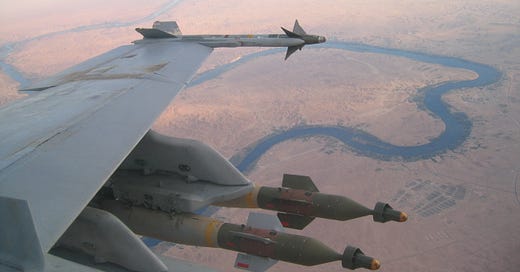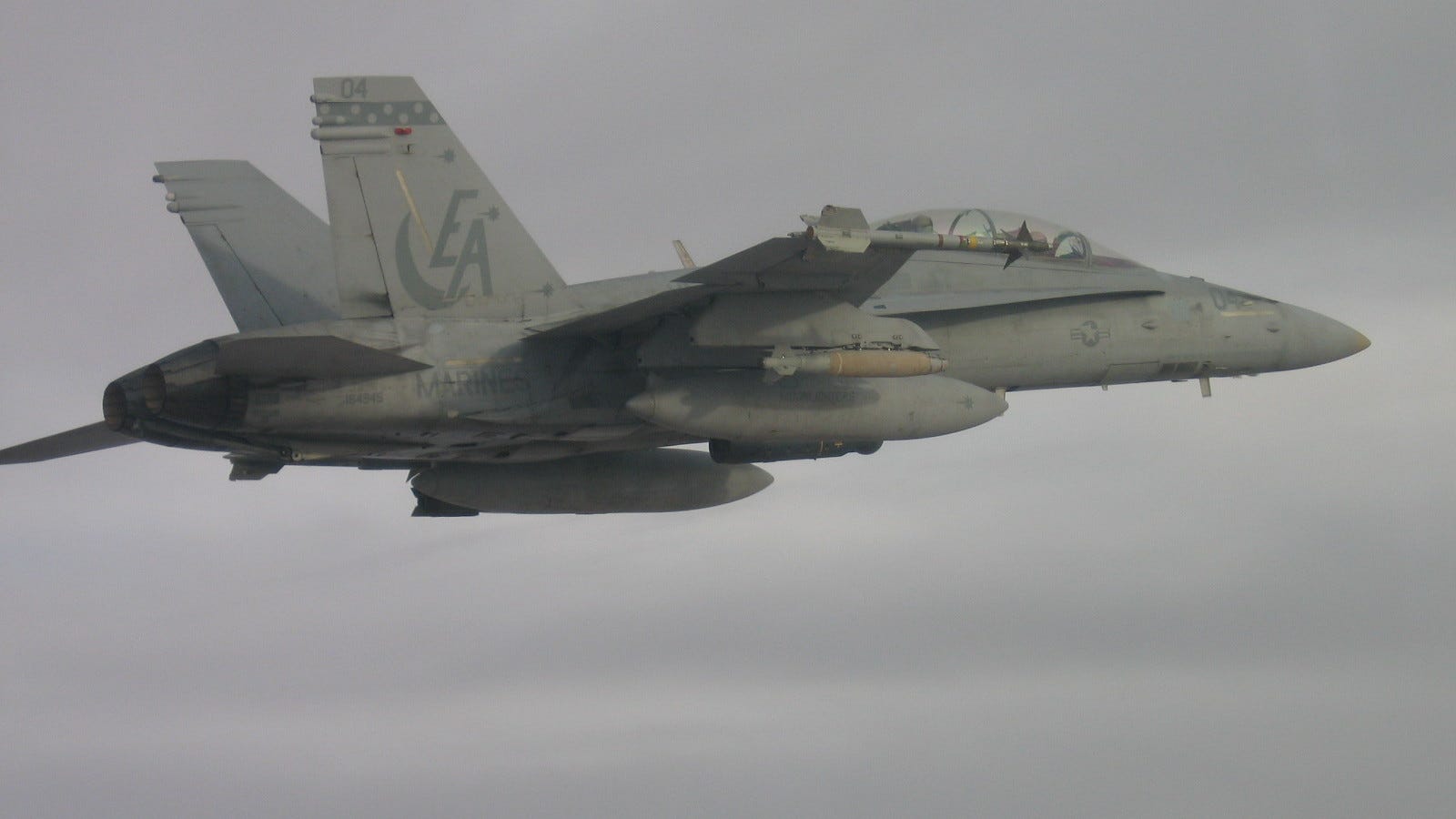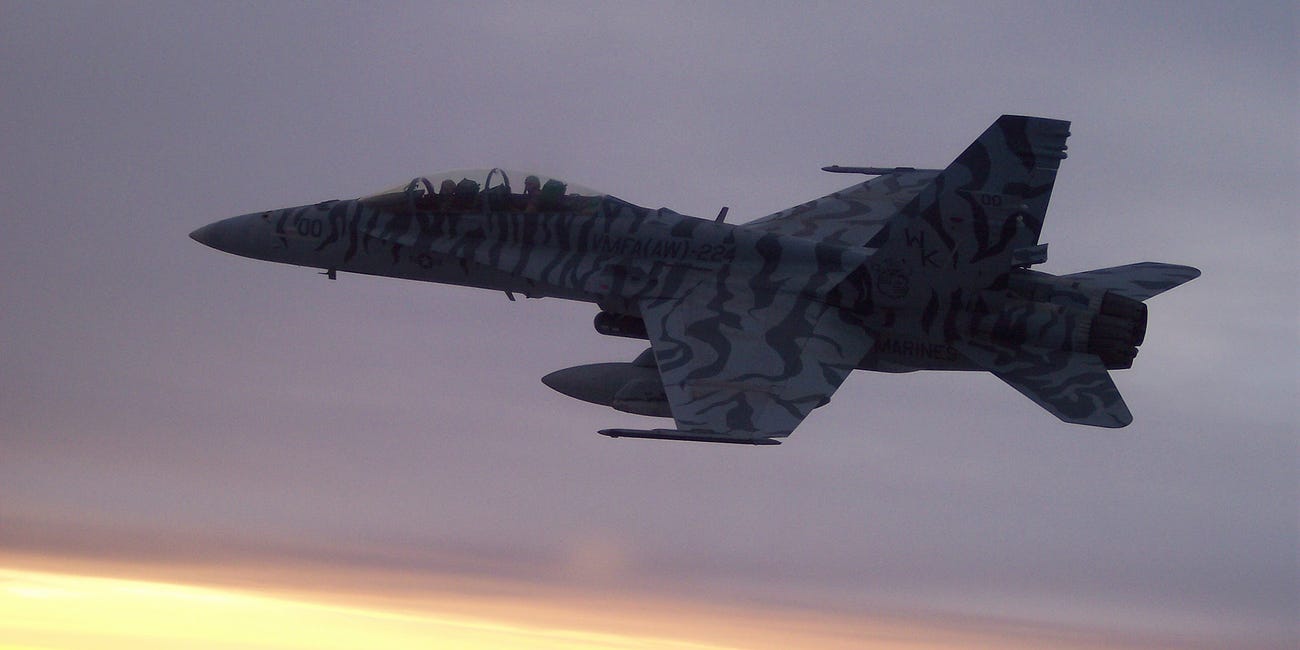Virtual Reality Air War
In 2005 and 2006, U.S. Marine Corps fighter pilots fight an insurgency from 10,000 feet
Between February 2005 and March 2006, I traveled to Iraq several times for The Village Voice—the New York City alternative newspaper that folded in 2017 and now reappears only sporadically. I wrote 16 stories for The Village Voice. The paper paid me $1,000 for each, essentially launching my writing career. This story The Village Voice appeared in February 2006.
Al Asad air base, Iraq—In early November 2005, thousands of U.S. Marines and U.S. Army soldiers swept through desolate Al Anbar province in western Iraq, pushing through the cities of Ar Ramadi, Hit and Kubaysah, aiming for the Syrian border. The goal, according to Marine Corps intelligence officer Capt. Jeremy Demott, was to “cleanse the province” of Sunni insurgents and foreign fighters.
The fighting was intense.
One group of Marines came under fire from 50 insurgents in a four-story hotel. The Marines radioed the crews of two Boeing F/A-18D Hornet fighter jets flying overhead. Twenty-six-year-old Capt. Christine Vallely was in the back seat of one Hornet, using a sophisticated camera pod to scout for bad guys, when the call for help came.
“So we dropped a laser-guided bomb into the hotel, then our wingman did, then we did again. Then there were other flights. We had to go to the tanker [to refuel]. Then we came back and watched our wingman shoot his gun at some guys fleeing the area. Unfortunately,” she says, “they got away.”
It’s a familiar story to the 38 aviators of Vallely’s unit, Marine All Weather Fighter Attack Squadron 332 “Moonlighters” from Beaufort, South Carolina.
Insurgents nest in Al Anbar’s shambling cities like rats. The urban environment often thwarts the most sophisticated sensors and weapons. Successful attacks send surviving bad guys only deeper underground. And despite 332’s relentless pace of operations and hundreds of bombs dropped, insurgents continue to ambush Marines on the ground and plant roadside bombs that blow up passing U.S. vehicles.
Sometimes it happens right under the fliers’ noses.
“Near Ramadi, we saw guys digging, putting an improvised explosive device in the ground,” Vallely says. “We didn't have a gun in our jet, so our wingman rolled in to shoot his gun. You could see the insurgents throw their shovels and run and hide in the bushes. We hit them again, then two of them walked away. Seeing those guys blatantly planting a bomb in the daylight was one of my most frustrating experiences.”
Some critics of the Iraq war say the U.S. is trying to fight terrorists, insurgents and religious extremists with weapons and methods inherited from the Cold War, where the threat was from tank armies and high-tech bombers. Proponents contend that Cold War tools can be adapted to defeat 21st-century insurgencies.
The Moonlighters wage their own battles in the middle of this debate, launching every day to bomb suspected insurgent hideouts and using million-dollar sensors to track thugs lugging AK-47s.
“Insurgents use improvised explosive devices made of rusty bombs, wires and batteries,” says Capt. Lindsay Nelson, 27. “We counter their efforts with $40-million airplanes and $2-million [camera] pods.”
One video taken during a Moonlighters mission shows satellite-guided bombs flattening an abandoned mansion reportedly housing an insurgent cell. The roiling cloud of smoke and dust cleared to reveal a gutted building and mounds of charred debris. Anyone inside would have been vaporized in the blast or smashed in the collapse of the building.
The crisp, silent video images belie the grizzly results of 332’s work. “What we do, it’s not nearly as cool as Top Gun and the movies would make you believe,” says 26-year-old 1st Lt. Donny Hall, the squadron’s youngest and most junior flier.
Massive overkill, the extreme distance from which they attack and the heavenly environment that is their day-to-day milieu has a displacing effect on these highly-trained aviators. “It’s so sterile,” Hall says of his work. And during meals at Al Asad's bustling dining hall, the fliers are eager to ask this visiting journalist what it’s like outside the concrete and barbed-wire walls of their air base.
Which is ironic, since on any one of their daily missions, streaking over Al Anbar at 10,000 feet, gazing all the way to Baghdad, a hundred miles away, or to the equally-distant Syrian border, 332’s aircrews see more of Iraq’s barren landscape than even the most seasoned journalist.
The sense of virtual reality is a common result of flying high-performance aircraft. Maj. Joseph Reedy, 36, says low clouds below and clear nights above create what fliers call “the milk bowl.”
“The other night, we went out and we were inside a cloud, and we couldn’t hardly see anything. We’re inside this hazy layer where it's almost as if ... we’re sitting in Beaufort ... in a simulator, because there's no real way to know we’re moving at 300 miles per hour through the sky. It was a smooth night and there wasn’t really any wind, nothing really flying by, no sensation of moving at all. The two feet of this cockpit is all there is, and everything outside the window is some kind of simulated environment.”
If there’s one thing that pulls these fliers’ heads out of the (proverbial) clouds and dispels the feelings of unreality, its their close relationships with the Forward Air Controllers, or FACs, Marines on the ground whose job it is to talk jets onto a target using radios.
“A lot of [the FACs] are Marine Corps aviators. They’re guys I went to flight school with,” says 29-year-old Capt. Chris Arms. “When I talk to a guy, I know that’s my buddy down there. I’m going to do everything I can, squeeze every drop of gas out of the airplane to stay on station as long as I can. You got Marines on the ground, Marines in the air ... it’s definitely a more personal relationship.”
On one mission supporting the U.S. offensive in November 2005, some Marines were under attack from all angles. Their FAC was begging for help the second Reedy and Arms, flying separate jets, arrived over the battlefield, but cloud cover prevented them from seeing any bad guys and restricted what weapons they could use.
“We’re going to have to get below the weather,” Reedy told the FAC.
Parting the clouds to use their guns, the contested city coalesced around them. Reedy describes a hellish scene. Tracers stitched the landscape. Artillery flashed on impact. “That was the first time I’ve observed a lot of ground fire on the deck. We could see impacts. There was a big firefight going on there.”
“We were able to get enough air space below the clouds,” Arms continues. “The first time we pointed our nose at the deck with the gun was a pretty eye-opening experience, because I’d never ’til that point seen how much was going on on the ground. There were explosions going off everywhere. It looked like fireworks on the ground. I didn’t know what was enemy, what was friendly. All I knew was my [backseater] said ‘That's the target.’ I said, ‘Roger,’ rolled in there, squeezed the trigger ... and thought, ‘Holy cow. This is what it looks like.’”
When their remote war begins to take a psychological toll, the Moonlighters remind themselves that they’re here to help the Marines and soldiers on the ground, the men and women fighting the grueling daily battles in this lawless province.
Hall says he got an email from his wife back in Beaufort. She had just seen a video of some of the Moonlighters’ missions. “She said she was really proud of me, because for each one of those explosions, somebody’s getting to go home to see their families ... you know, you saved some lives out there. It made me proud to be doing what I’m doing.”
Still, waging war from 10,000 feet can seem rather abstract, and Hall says he forces himself to confront the reality of the bombs under his jet’s wings and of the Marines below who are counting on him for help. “The big thought is, please don’t let me screw this up.”
Read more:
Masters of None
This story originally appeared in 2006. In January 2005, Marine All Weather Fighter Squadron 224 “Bengals” deployed 38 fliers, 210 maintainers and all 12 of its two-seat Boeing F/A-18D Hornets to Al Asad airbase, 150 miles west of Baghdad, for a seven-month tour supporting coalition ground forces.







